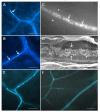Phloem parenchyma transfer cells in Arabidopsis - an experimental system to identify transcriptional regulators of wall ingrowth formation
- PMID: 23630536
- PMCID: PMC3634129
- DOI: 10.3389/fpls.2013.00102
Phloem parenchyma transfer cells in Arabidopsis - an experimental system to identify transcriptional regulators of wall ingrowth formation
Abstract
In species performing apoplasmic loading, phloem cells adjacent to sieve elements often develop into transfer cells (TCs) with wall ingrowths. The highly invaginated wall ingrowths serve to amplify plasma membrane surface area to achieve increased rates of apoplasmic transport, and may also serve as physical barriers to deter pathogen invasion. Wall ingrowth formation in TCs therefore plays an important role in phloem biology, however, the transcriptional switches regulating the deposition of this unique example of highly localized wall building remain unknown. Phloem parenchyma (PP) TCs in Arabidopsis veins provide an experimental system to identify such switches. The extent of ingrowth deposition responds to various abiotic and applied stresses, enabling bioinformatics to identify candidate regulatory genes. Furthermore, simple fluorescence staining of PP TCs in leaves enables phenotypic analysis of relevant mutants. Combining these approaches resulted in the identification of GIGANTEA as a regulatory component in the pathway controlling wall ingrowth development in PP TCs. Further utilization of this approach has identified two NAC (NAM, ATAF1/2 and CUC2)-domain and two MYB-related genes as putative transcriptional switches regulating wall ingrowth deposition in these cells.
Keywords: Arabidopsis; phloem parenchyma; transcription factors; transfer cells; wall ingrowths.
Figures

References
-
- Amiard V., Demmig-Adams B., Mueh K. E., Turgeon R., Combs A. F., Adams W. W. (2007). Role of light and jasmonic acid signaling in regulating foliar phloem cell wall ingrowth development. New Phytol. 173 722–731 - PubMed
-
- Andriunas F. A., Zhang H. M., Weber H., McCurdy D. W., Offler C. E., Patrick J. W. (2011). Glucose and ethylene signalling pathways converge to regulate trans-differentiation of epidermal cells in Vicia narbonensis cotyledons. Plant J. 68 987–998 - PubMed
-
- Cao S., Jiang S., Zhang R. (2006). The role of GIGANTEA gene in mediating the oxidative stress response and in Arabidopsis. Plant Growth Regul. 48 261–270
-
- Chen L. Q., Qu X. Q., Hou B. H., Sosso D., Osorio S., Fernie A. R., et al. (2012). Sucrose efflux mediated by SWEET proteins as a key step for phloem transport. Science 335 207–210 - PubMed
LinkOut - more resources
Full Text Sources
Other Literature Sources
Molecular Biology Databases
Miscellaneous

